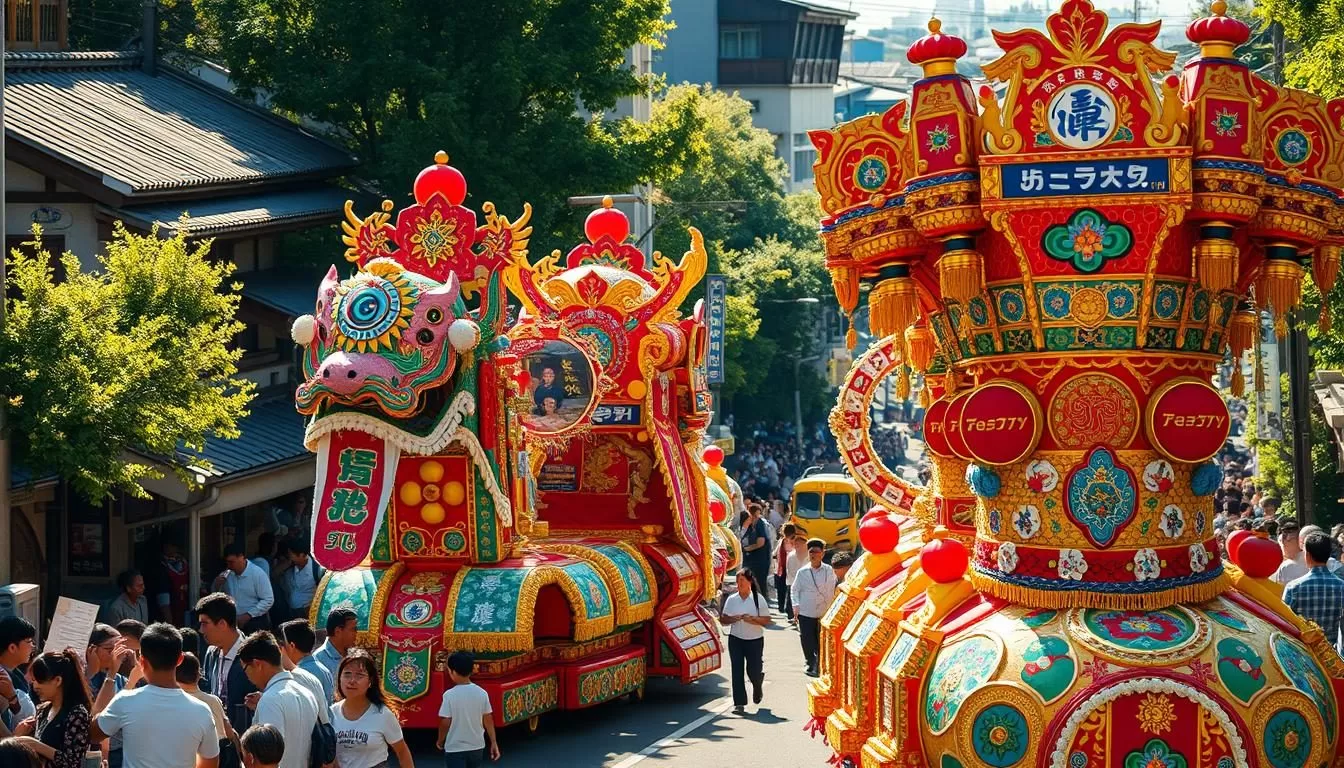You’re in for a treat if you’re planning a trip to Hyōgo Prefecture, as its festivals are deeply rooted in culture and are a great way to experience the local community spirit.
Throughout the year, Hyōgo Prefecture hosts various events that showcase its rich heritage, from spring festival celebrations to summer fireworks displays and autumn harvest festivals.
One of the most spectacular festivals is the Nada no Kenka “Fighting Festival,” where participants dramatically clash portable shrines. You’ll discover why Hyōgo Prefecture is a treasure trove of authentic Japanese culture and festival experiences.
The Cultural Significance of Festivals in Hyōgo Prefecture
Hyōgo Prefecture’s festivals are a vibrant expression of the region’s unique cultural identity. As you explore the prefecture, you’ll discover that its festivals are an integral part of the local culture, reflecting the community’s history, geography, and traditions.
The Role of Matsuri in Japanese Society
In Japan, matsuri (festivals) play a crucial role in community life, often centered around Shinto shrines or Buddhist temples. These events are not just celebrations; they are vital to the social fabric, fostering community bonding and cultural continuity. Festivals like the Mitsuyama festival, which takes place once every 20 years, are significant cultural events that have been carried out since 939.
Hyōgo’s Unique Festival Heritage
Hyōgo Prefecture boasts a diverse range of festivals, influenced by its geographical location and historical background. The prefecture’s unique blend of coastal and mountainous regions has given rise to distinct festival traditions. For instance, the Mitsuyama festival features three towering wood structures decorated with colorful cloth to welcome spirits.
| Festival | Location | Frequency |
|---|---|---|
| Mitsuyama Festival | Himeji | Every 20 years |
| Nada no Kenka Festival | Himeji | Annual |
Understanding Japanese Festival Traditions
To truly appreciate the festivals in Hyōgo, it’s essential to understand the significance of traditional elements like mikoshi and dashi. These components are integral to the festival experience, offering insights into Japanese culture and history.
Mikoshi and Portable Shrines
Mikoshi are portable shrines believed to carry the spirit of a deity. During festivals, participants carry these shrines through the street, symbolizing the deity’s journey among the people. The vibrant decorations and intricate designs on mikoshi reflect the community’s craftsmanship and devotion.
Dashi, Yatai, and Festival Floats
Dashi, yatai, and other festival floats are elaborate structures that play a crucial role in Hyōgo’s festivals. They often feature music and performances, entertaining both the attendees and the deities. The floats come in various shapes and sizes, showcasing the region’s rich cultural heritage.
| Float Type | Description | Features |
|---|---|---|
| Dashi | Two-storied vehicles with gabled roofs | Intricate wood carvings, gold leaf decoration |
| Yatai | Ornate floats with elaborate embroidery | Mechanical dolls, traditional performances |
| Yama and Hikiyama | Floats with distinct regional designs | Regional music, cultural performances |
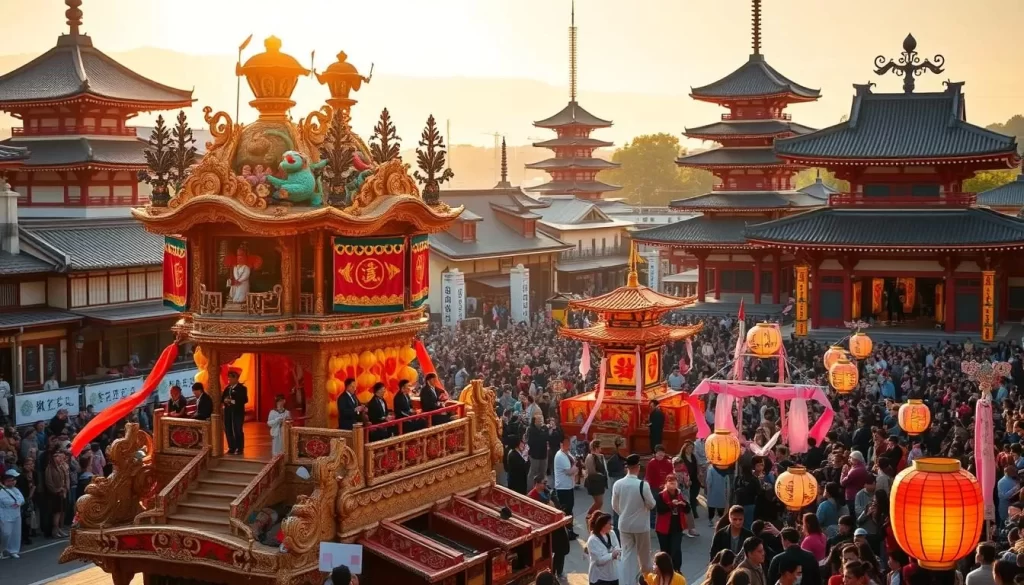
Spring Festivals in Hyōgo Prefecture
Hyōgo Prefecture’s spring festivals offer a captivating blend of tradition, culture, and natural beauty. As the season awakens, the region comes alive with vibrant celebrations that showcase its rich heritage.
Cherry Blossom Celebrations
Spring in Hyōgo is synonymous with cherry blossom viewing. The prefecture is home to numerous beautiful cherry blossom spots, attracting visitors from across the globe. These celebrations are not just about the beauty of the blossoms but also about the cultural significance and communal joy they bring.
Mitsuyama Festival in Himeji
The Mitsuyama festival of Itatehyōzu Shrine in Himeji takes place once every 20 years. This ancient ritual, dating back to 939, features three towering wooden structures representing mountains, decorated with colorful cloth to welcome spirits. The festival takes place with great fervor, preserving elements that have disappeared from other Japanese celebrations, making it a unique cultural experience.
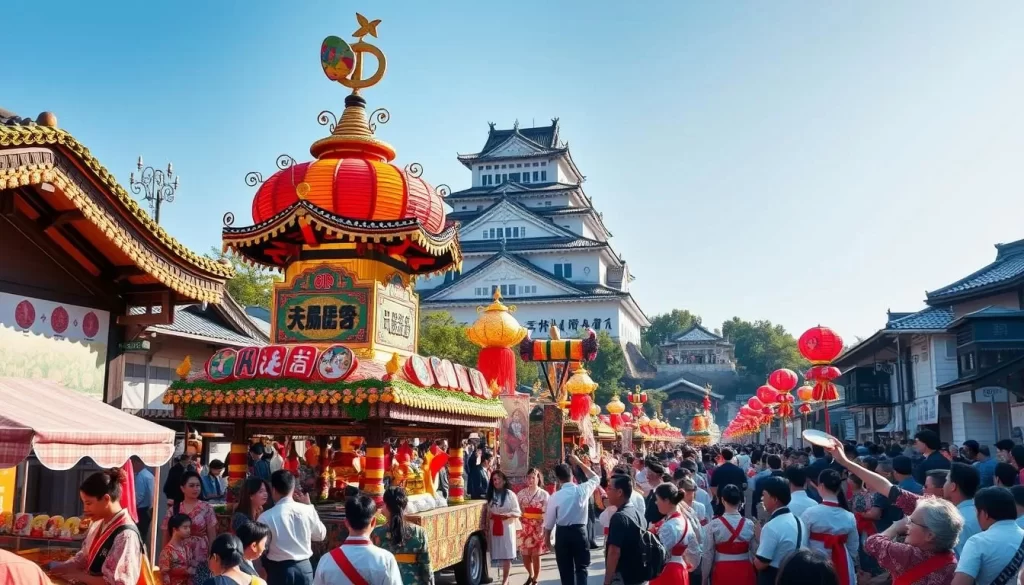
The Famous Nada no Kenka Festival
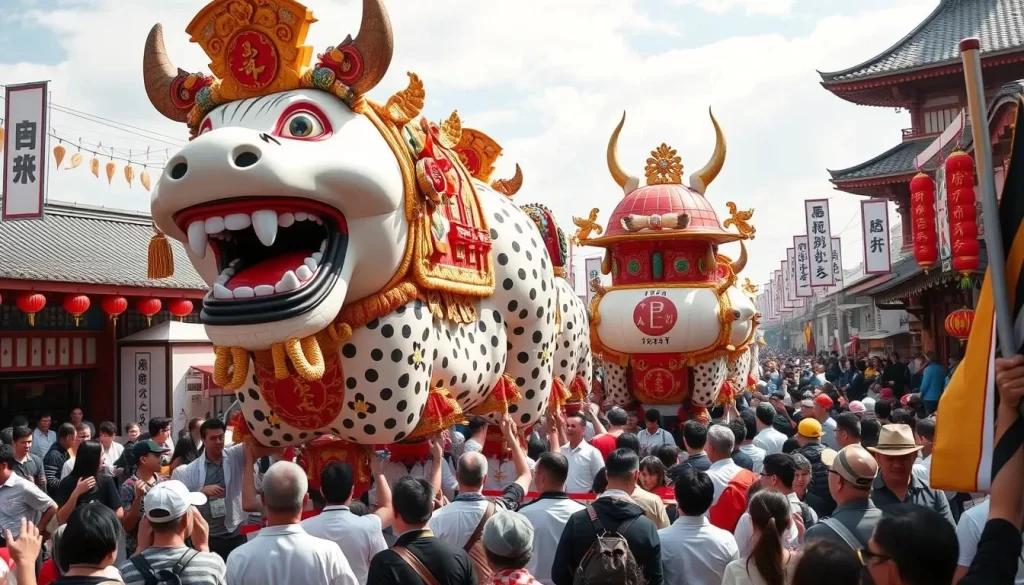
The Nada no Kenka Festival is a renowned event in Himeji, known for its unique and exhilarating spectacle. This festival is a significant cultural experience, offering insights into traditional Japanese customs and community spirit.
History and Significance
The Nada no Kenka Festival has a rich history, deeply rooted in the local culture and traditions. It is held at Matsubara Hachiman Shrine, where the floats from seven districts are assembled for worship. The festival symbolizes the legend of Jingū, a legendary empress enshrined at the shrine, and her fleet of ships rubbing against each other to remove oyster shells from their hulls.
What to Expect at the “Fighting Festival”
During the festival, you’ll witness the dramatic confrontation between teams carrying massive 2.5-ton floats, known as floats, through the streets. These teams, consisting of 200 to 300 parishioners each, deliberately crash their floats together, creating a stirring sight. Additionally, three portable shrines, or mikoshi, clash in a display of strength and devotion, believed to please the deities. This spectacular event is a true representation of the community’s spirit and cultural heritage, all taking place at the revered shrine.
As you experience the Nada no Kenka Festival, you’ll be immersed in a unique cultural event that showcases the strength, tradition, and community bonding that defines this festival. The floats, adorned with intricate designs, are a marvel to behold as they are maneuvered through the crowded streets, highlighting the precision and coordination among the participants.
Summer Fireworks Spectaculars in Hyōgo
One of the highlights of summer in Hyōgo Prefecture is undoubtedly the array of fireworks festivals that take place across the region. These events are a cherished part of Japanese summer culture, offering a unique blend of traditional celebration and modern spectacle.
Minato Kobe Fireworks Festival
The Minato Kobe Fireworks Festival is a standout event, attracting visitors from across the country with its stunning display of fireworks over Kobe’s harbor. This festival is a perfect example of how Hyōgo’s city areas come together to celebrate the summer season.
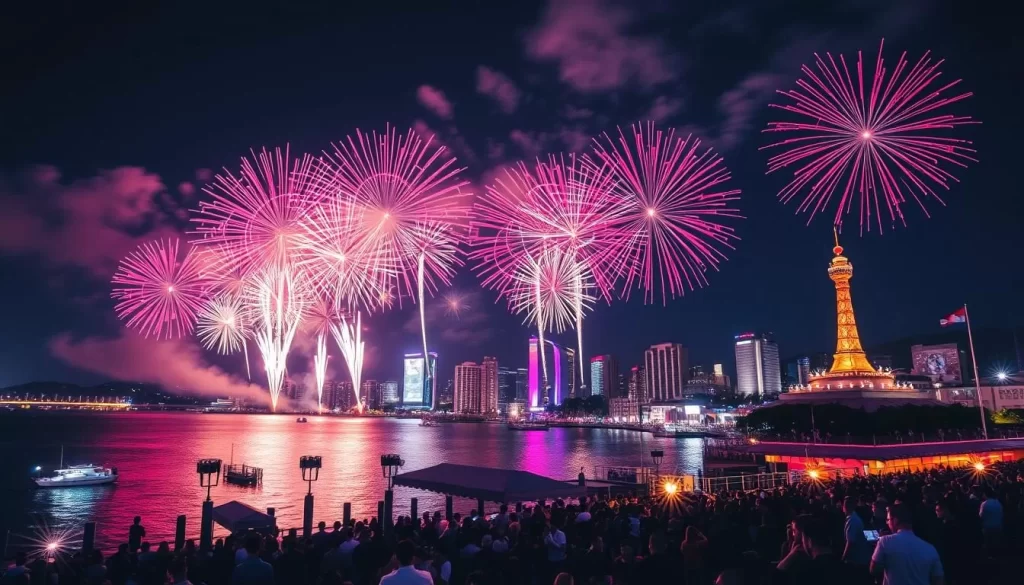
Himeji Minato Maritime Fireworks Show
The Himeji Minato Maritime Fireworks Show is another highlight, celebrating Himeji’s maritime heritage with a spectacular display of fireworks. The event commemorates the opening of Himeji Port, with a special celebration held every year, including a notable 60th-anniversary celebration featuring 6,000 fireworks.
The fireworks are launched from barges in the harbor, creating a breathtaking reflection on the water that enhances the visual experience of the fireworks display.
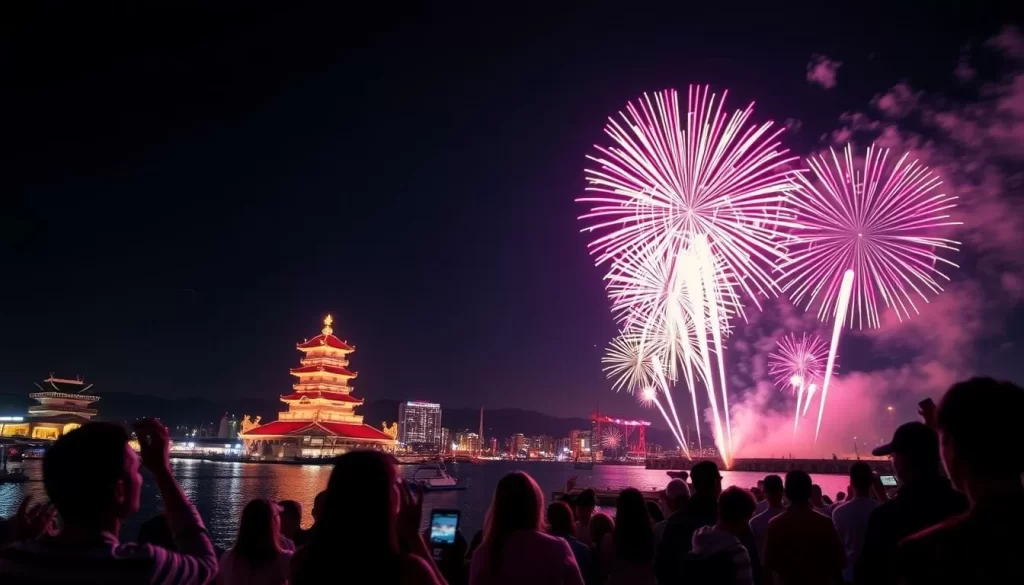
More Summer Fireworks Displays Worth Visiting
Beyond the famous festivals, Hyōgo Prefecture offers more hidden gems of summer fireworks displays. These events are sure to captivate you with their vibrant colors and festive atmosphere.
Ashiya Summer Carnival
The Ashiya Summer Carnival is a delightful event that features a spectacular fireworks display. You can enjoy the fireworks lighting up the summer night sky, creating a magical ambiance.
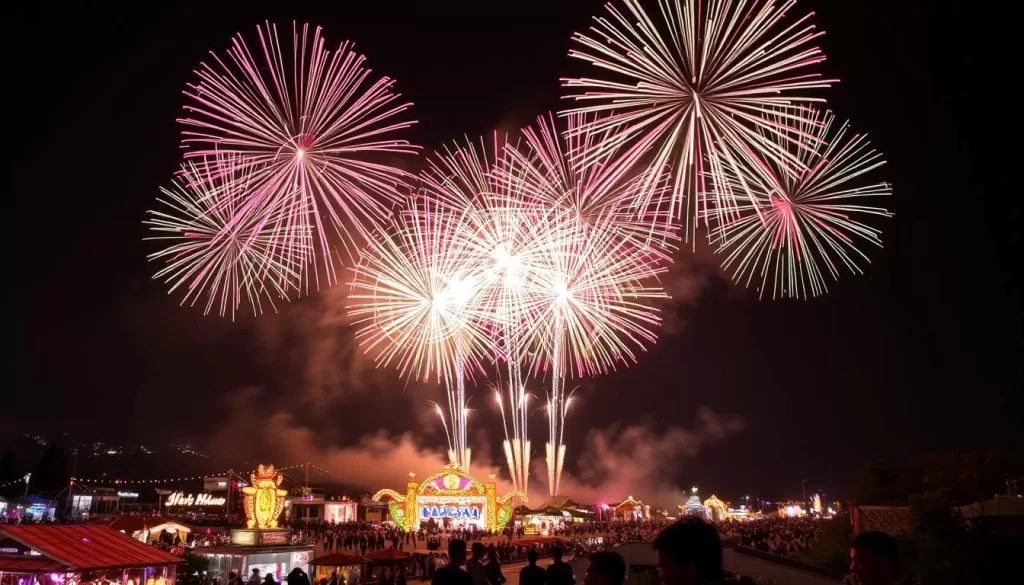
Kakogawa Festival Fireworks
The Kakogawa Festival & Fireworks Display is an annual highlight, featuring around 5,000 fireworks launched from the Kakogawa River. The display, which takes place on a summer evening, creates a breathtaking scene as the night sky is illuminated.
You can enjoy this festival on Sunday, August 4th, from 19:30 to 20:30. The event offers a complete summer experience with food stalls, games, and entertainment, making it a must-visit event.
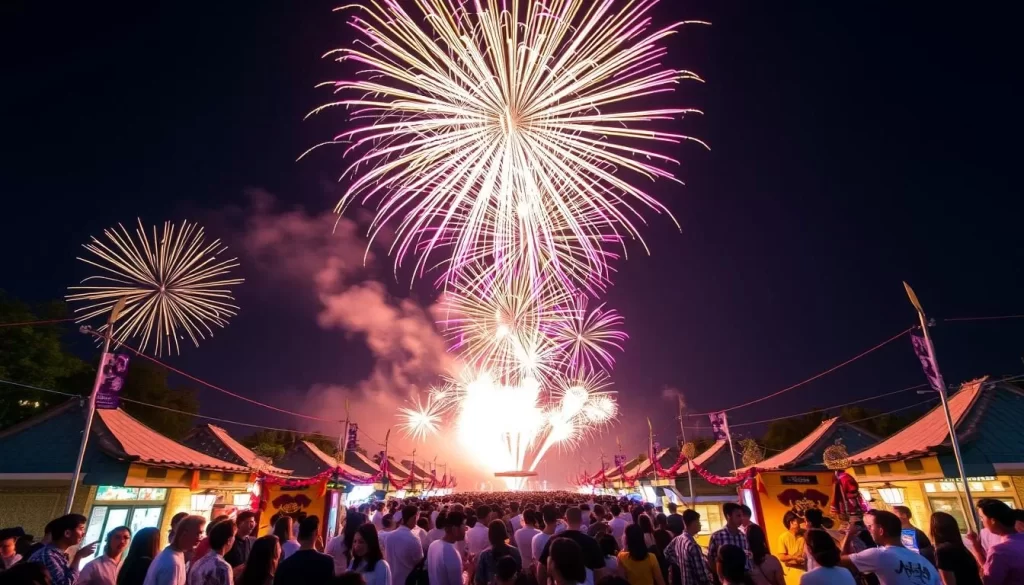
Traditional Summer Festivals in Hyōgo
The warmest months of the year in Hyōgo Prefecture are marked by numerous summer festivals, or ‘matsuri,’ that are integral to Japanese culture. These events transform the streets of towns and villages into vibrant celebration spaces, filled with food stalls offering regional specialties and summer favorites.
Bon Odori Celebrations
One of the highlights of Hyōgo’s summer festival season is the Bon Odori celebrations. This traditional dance festival honors the spirits of ancestors and is characterized by lively performances around a central stage, often accompanied by traditional music and food stalls.
Local Summer Matsuri
In addition to Bon Odori, various towns across Hyōgo Prefecture host their own unique summer matsuri. These local festivals often feature traditional performances, games for children, and a wide range of street food, making them enjoyable for visitors of all ages.
Autumn Festival Highlights
Hyōgo Prefecture’s autumn festivals offer a unique blend of tradition, culture, and community spirit. As the season changes, the region comes alive with vibrant celebrations that bring families together.
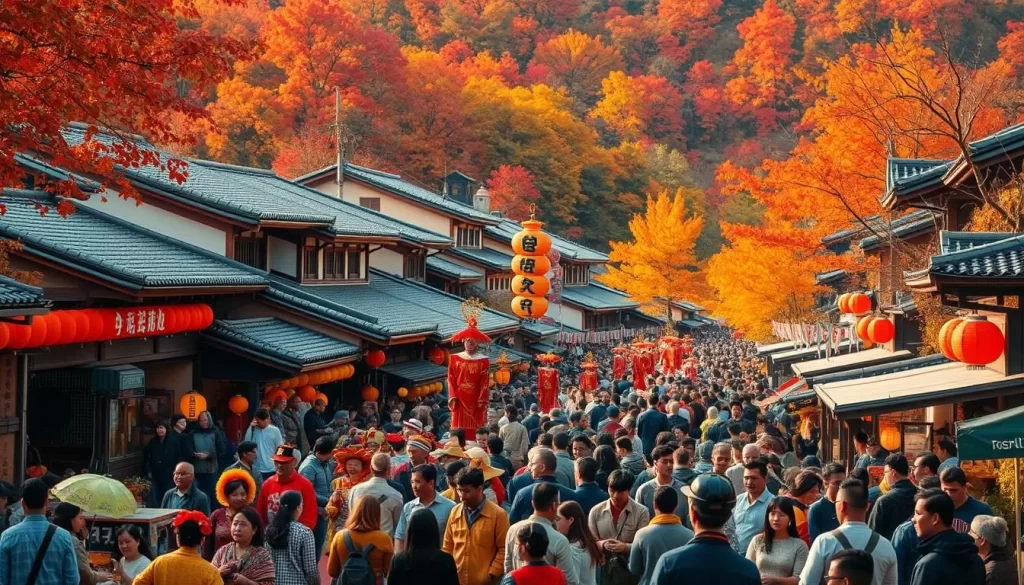
The autumn celebration is marked by two significant events: Harvest Celebrations and Moon-Viewing Festivals.
Harvest Celebrations
During the harvest season, communities in Hyōgo Prefecture come together to give thanks for the bounty of the land. These celebrations often feature traditional foods, dances, and rituals to mark the occasion.
Moon-Viewing Festivals
As night falls, the Moon-Viewing Festivals, or “tsukimi,” take center stage. People gather at historic temples, gardens, and mountaintop vistas to admire the full moon, often accompanied by traditional foods like tsukimi-dango (round rice dumplings) that symbolize the full moon.
Winter Festivals and New Year Celebrations
As the year draws to a close, Hyōgo Prefecture ushers in the winter season with a variety of captivating festivals and New Year celebrations. You can experience the unique cultural heritage of the region during this time.
One of the significant events during this period is Setsubun, a traditional ritual marking the end of winter and the beginning of spring. You can participate in the famous bean-throwing ceremony, known as mamemaki, where participants shout “Oni wa soto, fuku wa uchi” (demons out, good fortune in) while scattering roasted soybeans.
Winter Illuminations
Hyōgo Prefecture is also known for its beautiful winter illuminations, which add to the festive atmosphere. You can visit various locations throughout the prefecture to enjoy these spectacular displays.
Setsubun and Early Spring Rituals
Setsubun celebrations are held at shrines and temples throughout Hyōgo Prefecture, attracting thousands of participants. You can observe or participate in these local variations, which often involve families continuing these traditions at home.
For instance, in some households, the father wears a demon mask while children throw beans to drive away evil spirits, a practice that has been passed down through generations. This ritual is closely tied to the agricultural calendar, which has shaped Japanese cultural practices for centuries.
| Festival/Ritual | Location | Description |
|---|---|---|
| Setsubun | Shrines and Temples | Bean-throwing ceremony to ward off evil spirits |
| Namahage | Oga Peninsula, Akita | A ritual where men dress up as benevolent spirits to bring good fortune |
| Winter Illuminations | Various locations | Spectacular light displays during the winter season |
Unique Cultural Experiences at Hyōgo Festivals
As you immerse yourself in Hyōgo’s vibrant festivals, you’ll discover a world of unique cultural experiences that showcase the region’s rich heritage.
These events offer a mix of traditional performances, delicious food, and lively street stalls. You can enjoy various cultural delights, including traditional dances and music.
Traditional Performances
Hyōgo’s festivals feature a range of traditional performances, including dances, music, and theater. These performances are an integral part of the festival experience, showcasing the region’s cultural heritage.
Festival Foods to Try
When visiting Hyōgo’s festivals, be sure to try some of the local food, such as yakisoba, takoyaki, and karaage. You can also sample regional specialties like Kobe beef skewers and Akashi yaki.
Planning Your Visit to Hyōgo Prefecture Festivals
As you plan your trip to Hyōgo Prefecture, understanding the best time to visit and how to get around is crucial for a seamless festival experience. With numerous events spread across the area, efficient travel planning is key.
To navigate between city locations and enjoy the various festivals without hassle, you can utilize Japan’s excellent public transportation system. The JR Kobe Line, for instance, connects major city centers, making it easy to travel between popular festival sites.
Best Times to Visit
The best time to visit Hyōgo Prefecture for festivals largely depends on the season. Summer is peak festival season, with many fireworks displays and traditional summer matsuri taking place. Autumn and spring also host unique festivals worth attending.
Transportation Tips
Finding the most efficient way to travel between festival locations is straightforward, thanks to the comprehensive public transportation network. Using an ICOCA card can simplify your travel, allowing for easy passage through various transport systems.
| Transport Mode | Route | Frequency |
|---|---|---|
| JR Kobe Line | Kobe to Himeji | Every 10 minutes |
| Bus | Local city centers | Every 5-10 minutes |
| Shuttle Bus | Major festival sites | During peak festival times |
Festival Etiquette for Foreign Visitors
Visiting a Japanese festival can be a thrilling experience, but knowing the etiquette guidelines is essential for foreign visitors. As you immerse yourself in the vibrant atmosphere of Hyōgo Prefecture’s festivals, being respectful of local customs will enhance your experience and that of the people around you.
Cultural Sensitivity
When participating in or observing a festival, it’s crucial to be mindful of your surroundings and the cultural significance of the event. Take a moment to understand the context and significance of the rituals and ceremonies you’re witnessing. This will not only enrich your experience but also show respect for the local traditions.
Photography Guidelines
Capturing memories of your festival experience is a big part of the fun, but it’s essential to do so respectfully. When taking photos, be aware of your surroundings and avoid obstructing pathways or interfering with processions. If you wish to take a portrait of someone, use simple Japanese phrases like “Sumimasen” (excuse me) to ask for permission. Be particularly cautious during sacred rituals, as photography might be restricted or considered inappropriate at certain times.
| Occasion | Photography Etiquette | Respectful Behavior |
|---|---|---|
| Sacred Rituals | Avoid taking photos or be discreet | Observe quietly, follow crowd behavior |
| Processions | Take photos from a distance, avoid flash | Stand back, let participants pass |
| Portraits | Ask permission using “Sumimasen” | Be polite, respect refusal if any |
By being considerate of these guidelines, you’ll be able to take great photos while respecting the festival and its participants. Enjoy your time at the festival, and take in the vibrant atmosphere!
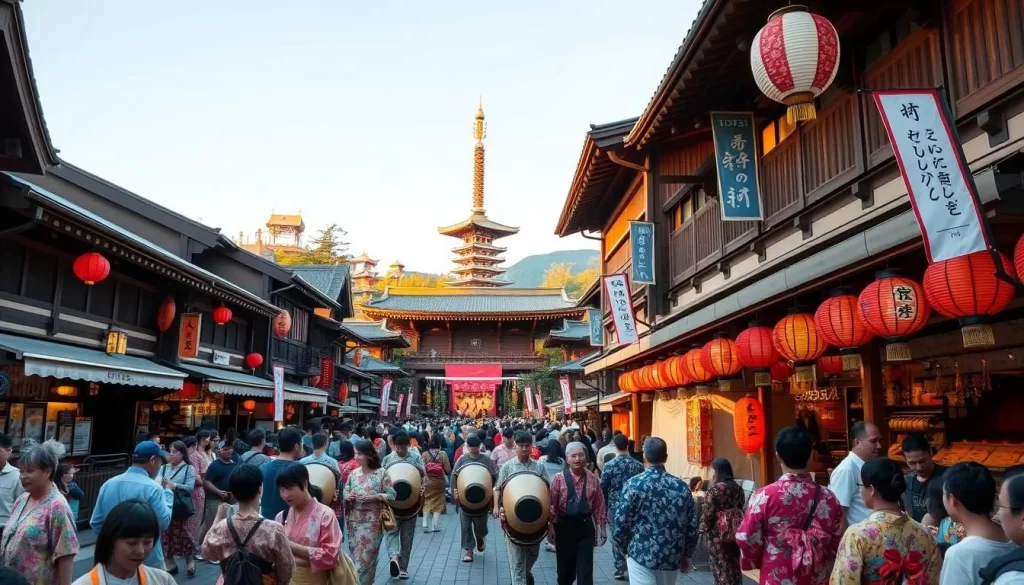
Where to Stay During Festival Season
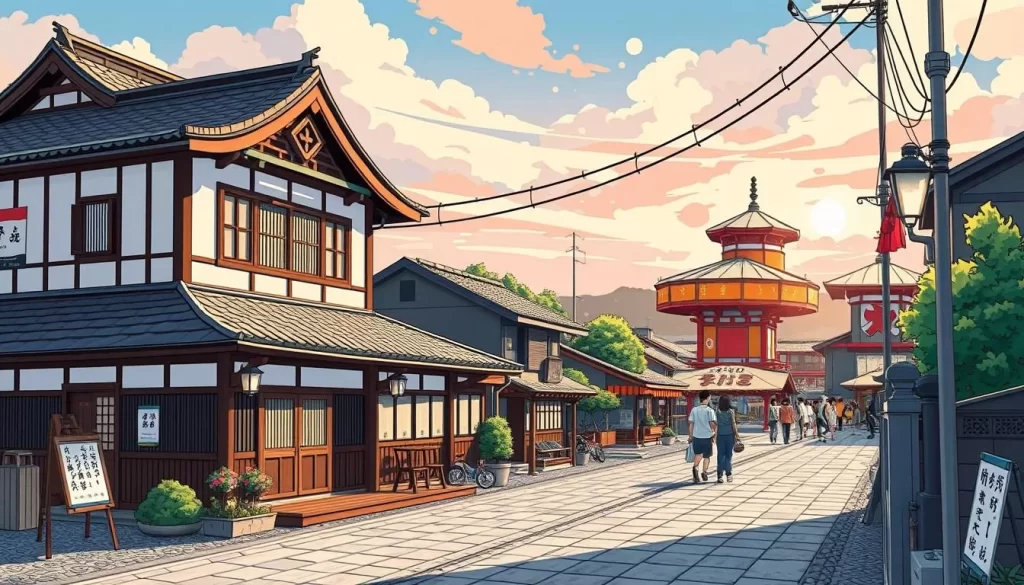
As festival season approaches in Hyōgo Prefecture, the demand for accommodations skyrockets, making early booking crucial. You’ll want to secure your stay well in advance to avoid the stress of last-minute arrangements.
Accommodations Near Major Festival Sites
When planning your visit to Hyōgo’s festivals, consider staying at accommodations near the major festival sites. This not only reduces travel time but also allows you to fully immerse yourself in the festival atmosphere. Many hotels and ryokans offer special festival packages, so be sure to inquire about these when you book your stay.
Booking Tips for Festival Periods
To ensure a smooth and enjoyable festival experience, follow these booking tips:
- You’ll discover why early booking is essential for accommodations during major festival periods, with some events requiring reservations 6-12 months in advance.
- We’ll explore strategies for finding available rooms when standard booking sites show “no vacancy” during popular festivals.
- You’ll learn about cancellation policies and flexible booking options that can help you secure accommodations while maintaining some travel flexibility.
- We’ll examine price fluctuations during festival periods and how to find the best value without compromising on location or comfort.
- You’ll understand alternative accommodation options, including home stays and temple lodgings, that might be available when conventional options are fully booked.
By planning ahead and being flexible, you can find the perfect place to stay during Hyōgo’s vibrant festivals, ensuring that your time is well spent enjoying the celebrations rather than searching for a place to stay.
What to Wear to Japanese Festivals
As you prepare to visit Hyōgo Prefecture’s vibrant festivals, considering what to wear is essential for an enjoyable day out. The right attire can enhance your experience, allowing you to fully participate in the celebrations.
Traditional Yukata and Festival Attire
Many visitors to Japanese festivals choose to wear traditional yukata, a casual summer kimono. Wearing yukata can add to the festive atmosphere and is a great way to immerse yourself in the culture. You can easily find yukata at local shops or rental stores near festival venues.
Practical Clothing Considerations
While traditional attire is encouraged, comfort should not be compromised. Comfortable clothing and footwear are crucial, especially for festivals that involve extensive walking or standing. Be sure to wear shoes that are suitable for the terrain and bring layers for cooler weather in the evening. Don’t forget to check the weather forecast for the day of the festival to ensure you’re prepared.
Combining Festival Visits with Other Hyōgo Attractions
Your visit to Hyōgo Prefecture can be a rich experience, blending the excitement of festivals with the area’s natural charm. The region offers a diverse range of activities and sights that can be enjoyed alongside its vibrant festivals.
Historic Sites Near Festival Locations
Many of Hyōgo’s festivals are held near historic sites, allowing you to explore the local culture and history. For example, the Himeji Castle, a UNESCO World Heritage Site, is near the Mitsuyama Festival. You can visit this iconic castle before or after enjoying the festival.
Natural Attractions in Hyōgo Prefecture
Hyōgo Prefecture is not just about urban festivals; it also boasts stunning natural landscapes. The Rokko mountain range offers hiking trails, hot springs, and panoramic views, providing a perfect contrast to the bustling festival atmosphere. Coastal areas like Awaji Island and the Seto Inland Sea offer beautiful beaches and refreshing escapes.
| Attraction | Location | Best Time to Visit |
|---|---|---|
| Himeji Castle | Himeji | Spring or Autumn |
| Rokko Mountain Range | Kobe | Any season |
| Awaji Island | Awaji | Summer |
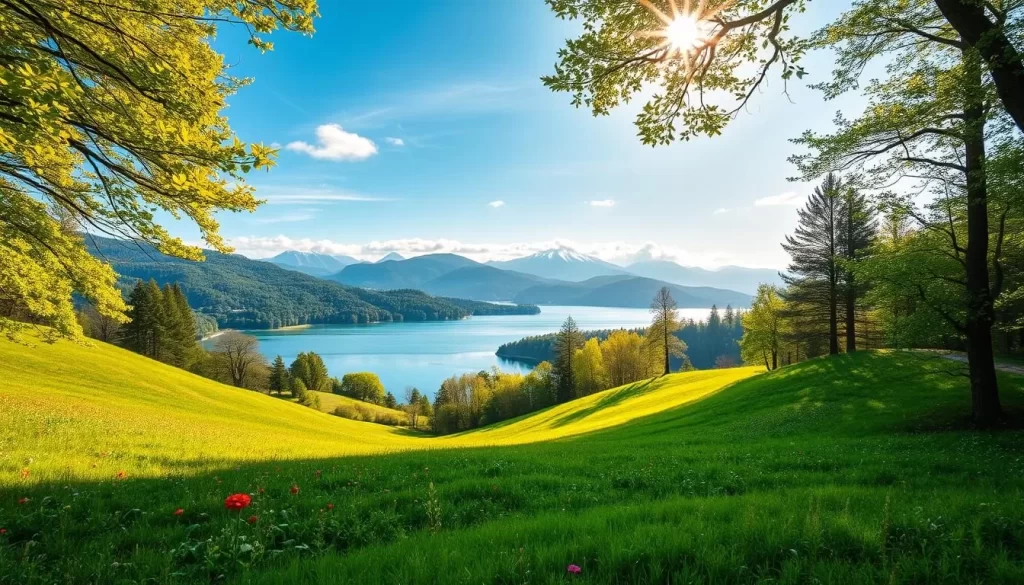
By combining festival visits with explorations of Hyōgo’s historic sites and natural attractions, you can create a well-rounded trip that showcases the best of the region. Whether you’re interested in culture, history, or nature, Hyōgo Prefecture has something to offer in every season.
Conclusion: Experiencing the Heart of Japanese Culture Through Hyōgo’s Festivals
The festivals of Hyōgo Prefecture are a gateway to understanding the depth and richness of Japanese culture. By visiting during festival seasons, you’ll gain a unique experience that goes beyond ordinary tourism, making your trip truly unforgettable.
Participating in Hyōgo’s diverse festivals creates lasting memories and deepens your connection to Japan’s heritage.
The above is subject to change.
Check back often to TRAVEL.COM for the latest travel tips and deals.
